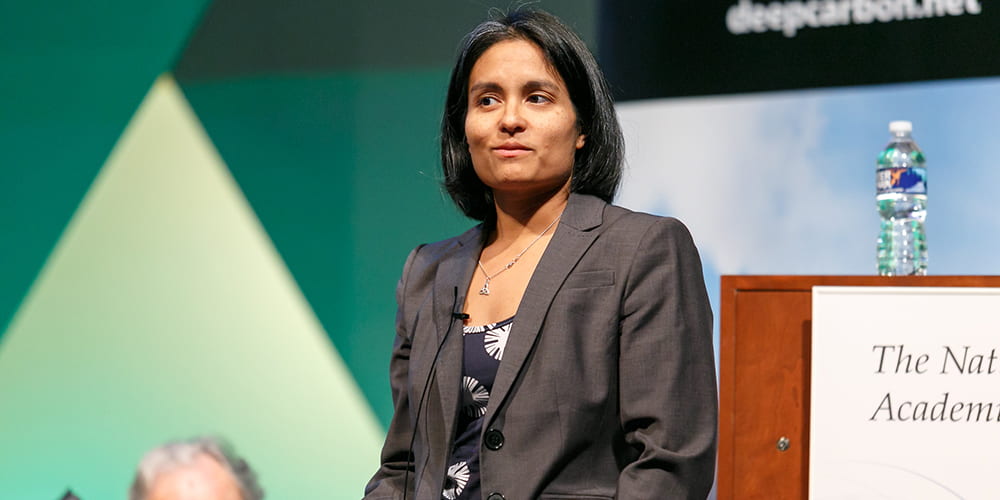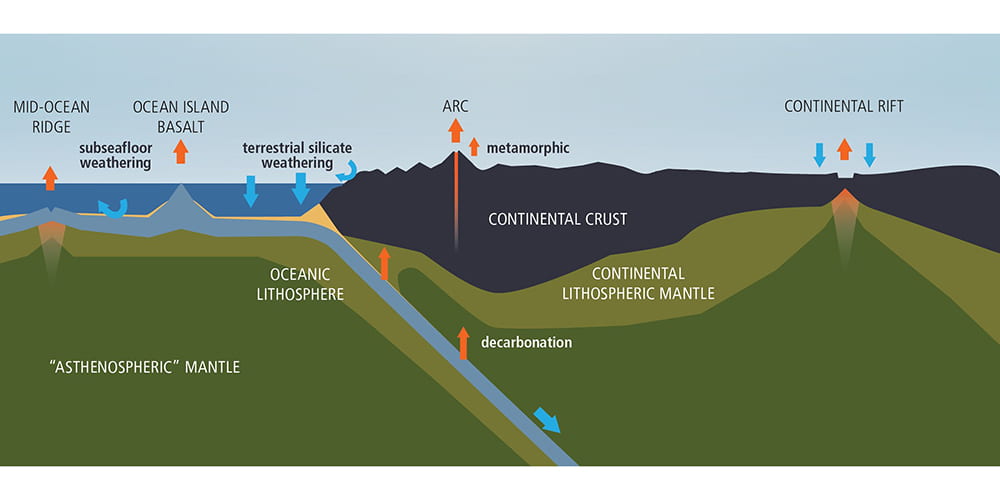A Deep Look at Deep Carbon

Carbon is everywhere. It is in the ground, in our food, in our bodies, in our oceans and in our air. Vast stores of carbon exist deep inside the planet in quantities that dwarf what’s aboveground. It moves through these two intertwined reserves in a process similar to the water cycle, maintaining a balance that allows life to flourish.
This carbon cycle is complex and multifaceted, it is a system in which surface carbon in the atmosphere, on land and in the sea is “subducted” into the planet’s interior via plate tectonics, and eventually returned to the surface through volcanic eruptions, outgassing and other metamorphic processes. The cycle has been largely stable and balanced throughout Earth’s history; the amount going down equals the amount coming back up.
Of course there have been times when that wasn’t the case. Its these exceptions – when the carbon cycle is out of balance and resulting affects to earth’s atmosphere — that interest Celina Suarez, associate professor of geosciences at the University of Arkansas. Suarez studies carbon cycle perturbations — large and sometimes sudden shifts in the amount of carbon released to the atmosphere. Her latest research, funded through a $588,000 NSF grant, looks at carbon isotopes in fossils to gain a better understanding of how the earth handled increased temperatures and carbon dioxide levels between 120 and 90 million years ago that mimic levels predicted for the future of the planet in the next 300 years,
Suarez’s work, along with breakthrough science that has changed our fundamental understanding of the carbon cycle, helps put modern climate conditions in perspective. The news isn’t good. “The last four mass extinctions are associated with these major carbon cycle events,” she said.
Peering Down
For something so ubiquitous and central to our existence, it’s surprising how little we knew about the role of carbon even 10 years ago. That began to change in 2009 when the private, non-profit Alfred P. Sloan Foundation committed $50 million in seed money over 10 years to establish the Deep Carbon Observatory, giving it the broad and ambitious mission of understanding carbon below the surface of the earth. A network of 1,200 scientists from 55 countries worked with the observatory studying the origin, quantity, movement and forms of carbon. They drilled into the ocean floor and collected samples from the summits of some of the world’s most inaccessible volcanoes. They descended deep into mines and worked in the inhospitable deserts of the Middle East.
What did they learn? That of the earth’s estimated 1.85 billion gigatons of carbon (a gigaton is a billion tons, so that’s 1.85 billion billion tons), fully 99.8 percent of it is located below the surface. That leaves a tiny fraction, the carbon we knew about, in the oceans, on land, in the atmosphere and in all living things.
Deep below the surface is where things get interesting. Down there the carbon harbors a vast biosphere, a community of life with a mass some 250 to 400 times more than the mass of all humans. These are microbes living at extreme pressures and temperatures that sustain themselves on hydrogen, methane or abiotic organic molecules instead of sunlight, a crush of life observatory scientists called a “subterranean Galapagos.” Some of the microbes have “geologic” lifespans, meaning they survive for thousands or millions of years on only the hydrogen from rocks. Life below the surface of the earth, it turns out, is comparable in diversity to that above it.
Out of Balance
The two systems are not equal; there is vastly more carbon under the ground than above it and carbon cycles much more quickly in the atmosphere and biosphere than in the planet’s mantle. But for most of the planet’s history, the amount of carbon going down into the Earth has roughly equaled the amount being returned to the atmosphere. The cycles have been in balance.

Suarez addressing members of the Deep Carbon Observatory in 2019. Photo courtesy of the Deep Carbon Observatory.
Suarez recently received a grant from the National Science Foundation for research on how climate and tectonic changes influenced the evolution, distribution and extinction of land-based life 90 million years ago in the Late Cretaceous period. She talked about her work in a recent edition of Short Talks From the Hill, a research podcast from the University of Arkansas.
Suarez focuses on the interruptions to that happy balance. Some are caused by catastrophic events, such as the asteroid or comet scientists believe hit the earth about 66 million years ago near Mexico’s Yucatan Peninsula, instantly vaporizing carbon-rich deposits and sending the greenhouse gas into the atmosphere. Other perturbations are caused by widespread volcanic activity releasing vast amounts of greenhouse gas into the atmosphere, as was the case with the end-Triassic extinction some 200 million years ago that wiped out about 76 percent of all marine and land species on Earth. “I’m interested in what causes those carbon cycle perturbations, how those carbon cycle shifts effect the environment, the climate, and how that climate affects origin and extinctions of life on land, and also distribution of animals and plants.”
She received a Deep Carbon Observatory grant to study the end-Triassic extinction as evidenced by fossils in Utah. Due to that work, and a prior NSF grant also studying the end-Triassic, she was invited to edit an issue of Elements, an international magazine on the topics of mineralogy, geochemistry and petrology, that explored the work of Deep Carbon Observatory scientists related to carbon-cycle perturbations.
While the observatory wasn’t tasked with examining “anthropogenic” sources of carbon – those released by the burning of fossil fuels – Suarez’s edition of Elements combined the observatory’s deep dive on the carbon cycle with present-day atmospheric carbon levels. The findings are sobering. “We do highlight the fact that the amount of carbon released to the atmosphere from human activity is about the same level of carbon released, at least the same magnitude of carbon released, during these carbon cycle perturbations associated with massive volcanic eruptions, as well as the meteor or asteroid impact,” Suarez said. “The modern carbon cycle is out of balance.”
Scientists measure shifts in atmospheric carbon by studying carbon isotopes, which are carbon atoms with the same number of protons but a varying number of neutrons. Suarez compares isotopes to milk: from skim to cream it’s all the same stuff, but the varying fat content imparts different characteristics. Same with carbon isotopes. By comparing modern atmospheric isotopic readings with carbon bound in fossils or ancient plants, it’s possible to track shifts in atmospheric carbon. Organic sources like those found in fossil fuels tend to be light isotopes, more skim milk than cream. And scientists are finding more of them in the atmosphere. “We are seeing very rapid shift in only 200 years, which is a very short time given the age of the Earth,” Suarez said.

The Earth has natural means to bring the carbon cycle back into balance, what Suarez calls “scrubbers.” Weathering breaks down rocks into component minerals that take up carbon and are ultimately pushed back into the mantle, organisms in the ocean take up atmospheric carbon into their bodies to create carbonate shells and sink when they die, land plants suck up CO2 into their tissues and put it into the soil when they die. “Earth’s natural carbon scrubbers will work,” she said. “But it takes up carbon in general at a much slower pace than what is outgassing into the atmosphere. Things will kind of correct themselves.”
The problem is that during past mass extinctions, the correction didn’t come quickly enough. How long will it take? “Most likely in about 10,000 or 100,000 years the carbon cycle will probably balance itself out, but that may be too late for much of Earth’s modern species.”



